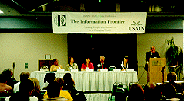
This year's United States Agricultural Information Network (USAIN) and International Association of Agricultural Information Specialists (IAALD) joint conference was a resounding success. Focusing on international cooperation and the use of new technologies for accessing agricultural information, the conference attracted nearly 200 agricultural information professionals from 36 countries. For three days, the conference provided opportunities for participants to network and gather information through papers, panels, project demonstrations, a poster session, and a variety of social events, including an informal "icebreaker" the evening before the official opening of the conference.
Keynote speakers on the first day focused on international themes. The
day began with Dr. Marcos Kisil, Program Director for the Latin American
and Caribbean Program of the Kellogg Foundation, speaking on the perspective
of the developing world on current information systems. At lunch, Mr. Thiendou
Niang, from the Centre Technique de Cooperation Agricule et Rurale (CTA),
provided a meaningful presentation on information partnerships in a constantly
changing world. Between these speakers were two concurrent papers sessions
and a well-attended poster session. This was followed by the evening dinner
which featured brief remarks by the sponsors of the event, Dean Carla Stoffle,
University of Arizona Libraries, and Dean Eugene Sander, the University
of Arizona College of Agriculture.
The second day started with an entertaining and thought-provoking talk
by Dr. Chuck McClure, Distinguished Professor in the School of Information
Studies at Syracuse University, New York, USA. Dr. McClure challenged the
audience to become more involved in the use of new communications technologies.
Continuing on this theme were speakers in another contributed papers session
as well as in a special presentation of the Agricultural Network Information
Center (AgNIC). The AgNIC project is being developed by a consortium of
U.S. land grant universities and the U.S. National Agricultural Library
to make available major agricultural information resources via the Web.
On the final day, the first speaker, Gary Paul Nabhan, author and Director of Research at the Arizona-Sonoran Desert Museum, began the day with a dynamic talk about "Giving communites a Voice by Integrating Regional, Multicultural Knowledge into Information Resources" which emphasized the value of collecting and incorporating indigenous knowledge with conventional knowledge.
Dr. Nabhan continued this line of thought in the Social Issues Interest Group panel presentation, "Bridging Traditional Knowledge of Place with Technical Environmental Knowledge." Other Interest Group panels were Document Delivery, which covered currently available services and developing services, including Docline, ARIEL (The Research Libraries Group), and CAL-CISTI (Canadian Agricultural Library and Information Management Services of Agriculture and Agri-Food Canada); Collection Management and Rural Information, which discussed "Agricultural Grey Literature, Alternative Literature, and State and Local Documents: Problems and Solutions for Information Management;" AGRICOLA Interest Group, which covered AGRICOLA, AGRIS, and CAB ABSTRACTS; and the Changing Information Environment Interest Group, which discussed "Rewriting the Rules: Coping with Change in the Information Chain."
Dr. Michael Reid, Associate Dean of the College of Agriculture, University of California, Davis, gave a thought-provoking talk during lunch about "Agricultural Problem Solving: Prospects for Use of the Internet" which included a demonstration with many examples shown.
Afternoon papers focused on building partnerships, training and strategic planning, designing information tools, and distance education. These were followed by an update from the U.S. National Agricultural Library and a final reporting session by the Interest Groups and by the Presidents of USAIN and IAALD. Evening tours of the Tucson area, complete with a desert sunset, provided the finale for the conference.
Funding from numerous sources helped make this unique event possible. The W.K. Kellogg Foundation provided travel support to 20 participants from Latin America and the Centre Technique de Cooperation Agricule et Rurale (CTA) brought a number of participants from Africa, the Caribbean and the Pacific Rim. In addition, the SOROS Foundation and the Research and Science Exchanges division of the United States Department of Agriculture helped cover the expenses of 16 professionals from Eastern Europe. Commercial exhibitors also added to the overall experience. Nineteen exhibitors filled the main hall including CAB International, Chemical Abstracts Service, the International Food Information Service, the Food and Agriculture Organization of the United Nations, Knight-Ridder Information, the U.S. National Agricultural Library, Silver Platter Information, and the Special Libraries Association.
Prior to the conference the Eastern European Roundtable, organized by the United States National Agricultural Library, held a two day meeting which involved presentations, discussion groups and the formulation of action agendas. In addition, 6 preconference workshops were held the day before the conference opened and included training in the Internet, Geographic Information Systems, strategies for handling institutional change, and in the use of the CAB ABSTRACTS, AGRICOLA, and Food Science and Technology Abstracts databases.
Barbara Hutchinson
Director, Arid Lands Information Center University of Arizona
1955 E. Sixth Street
Tucson, Arizona 85719
Phone: (520) 621-8578
Fax: (520) 621-3816
E-mail: barbarah@ag.arizona.edu